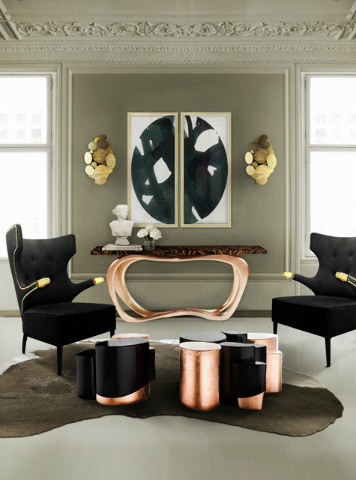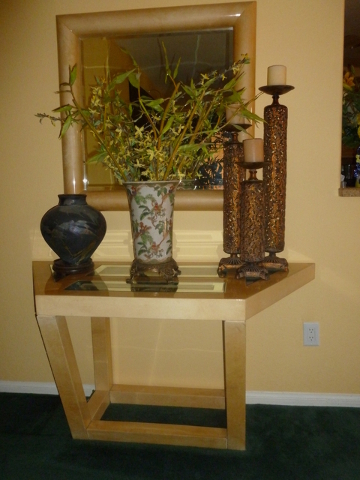Console: Hardest working table in design world
Only last week I was accompanying a client on a walk-through of her new custom home that was in the final stages of being dry-walled. That’s always an exciting time for both homeowner and designer because many of the fundamental elements in the building and design process finally seem to materialize for the first time and suddenly the home is “there.” It’s real, three-dimensional and the room proportions are what they are — for better or for worse.
As we studied the main entryway, the great room and the foyer outside the master bedroom, one piece of furniture kept popping up in our conversation — the console table. Yes, that all-purpose and omnipresent console table is the one item that can always be relied upon to fill a wall or serve a function, while complementing the surrounding decor all at the same time.
For sure, this is one piece of furniture that we love for more than just its good looks. Without a doubt, the console is truly the hardest working table in the design world and one that probably gets the fewest accolades or recognition for the essential contribution that it makes. Ubiquitous in all types of homes, consoles are naturally available in any number of furniture “period” styles as well and will go far to enhance the other furniture in your home.
Simply put, there’s no table that’s more multipurpose than the console. It’s been an integral and stalwart component of design ever since it was first introduced by those clever and creative Romans so many years ago, albeit in a slightly different form than we’ve been used to seeing.
Instead of having the usual four legs that we’ve come to associate with a console table, the early versions featured two front legs and were usually fairly small, say no more than 12 to 24 inches in width. And so clearly, since tables of this size couldn’t stand on their own, they had to be installed onto the wall. Consequently, there wasn’t too much attention paid to the actual design of these early consoles save for the front and top.
What we’ve become accustomed to calling a console table in the modern idiom is certainly different from those used in ancient times and is thought to have come about, like so much of the furniture we use today, sometime in France during the 18th century. The main difference between the two being that the majority of modern console tables now are comprised of four legs rather than just two.
The wall-hung console is also very much in use today for certain applications. For example, not too long ago, I was confronted with a narrow niche in an entry hall of a Country French home that called for a console table on which the homeowner hoped to display a beautiful crystal vase and other keepsakes. I designed a simple, hand-carved console table that featured only two graceful front legs with the table basically supported from brackets on the back wall, which worked to great success.
Homes of various designs have featured consoles that are simply wall-hung and work very well for helping to create a feeling of openness since they appear to “float.” In my experience, however, these types of consoles work best chiefly in a contemporary environment, which may account for their growing popularity in the future as homeowners and builders go more “modern” while at the same time scaling back on the size of new homes.
It’s important to note for those considering the use of a wall-hung type console that it usually contains none or very little storage space. As a result, the functionality of such a design is obviously greatly reduced.
It also presents a much greater challenge if you’re the type of homeowner who, from time to time, likes to rearrange the furniture for a fresh, new look. You’d be hard pressed to do so with a console that’s permanently attached to the drywall. So it’s something to think about before making a commitment to this type of table design.
Additionally, as a precautionary step, wall-hung consoles of a greater weight should ideally be hung on a wall that has been specially braced in order to safely support the console and avoid any potential mishap.
Along with coffee tables and end tables, designers usually classify consoles as “occasional tables,” with the console, of course, being much higher than the others — although its height can certainly vary depending on the application.
It’s been said that typically the height of a console table is approximately the same as the average adult’s hip height, or perhaps even an adult’s waist height. But there’s no absolute to this since, for example, consoles are often used as sofa-back tables, which would certainly cause them to be somewhat lower. In other words, go ahead and feel free to determine the height of your console based on your room’s proportions and its intended use, not by some predetermined formula.
There’s no better table to call upon to use in tricky areas of your home — such as hallways, niches, entryways or other problematic spaces — than the ever-ready console. Where in the world would we put our keys, the day’s mail or for that matter, any items that we need to be seen, (or not seen) without this all-purpose piece of furniture?
Whether made of wood or metal, and whether featuring a glass or a marble top, with storage or without, from the relatively cheap to the extremely expensive, you can rely on the console for its functionality and good looks.
Stephen Leon is a licensed interior designer and president of Soleil Design (soleildezine.com); he has been designing and manufacturing custom furniture and cabinetry for more than 25 years. He is past president of the Central California/Nevada Chapter of the American Society of Interior Designers and is a certified professional in green residential design. Questions can be sent to soleildesign@cox.net.


















